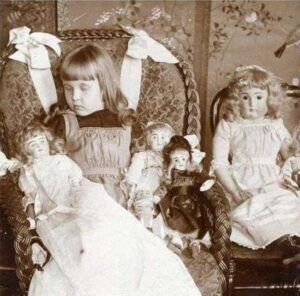by Makenna Johnston, dramaturg As you can see in The Turn of the Screw, the Victorian era was shrouded in death. Complications from industrialization, as well as high disease and infection rates, caused high mortality rates, especially in younger demographics. Because of this, the living found comfort in one of the most fascinating mourning practices of the Victorian era: post-mortem photography.

Due to the high cost of photography during the Victorian era, post-mortem photographs were often the first, and only, photographs families had taken of their loved ones. The mourning would commission a daguerreotype or a photograph taken by a long-exposure camera. Long exposures when taking photographs meant that the dead were often seen more sharply than the slightly-blurred living, because of their lack of movement.

The dead were carefully posed to appear as if they were still alive. Some deceased were propped against stands or furniture while others were surrounded by their family members or favorite toys. Once the daguerreotype photographs finished developing, some photographers would paint eyes or add blush to the finished photograph to make the deceased appear more lifelike.

Below are more examples of post-mortem photography. How do you choose to remember those who have passed on?




Sources: Bell, Bethan. “Taken from Life: The Unsettling Art of Death Photography.” BBC News, BBC, 4 June 2016, www.bbc.com/news/uk-england-36389581. Diaries, Ghost, et al. “Memento Mori: The Macabre Victorian Art of Death Photography.” The Occult Museum, 16 May 2017, www.theoccultmuseum.com/memento-mori-macabre-victorian-art-death-photography/. Leahabaza. “Picturing the Dead: Victorian-Era Mourning and Post-Mortem Photography.” Woodland Cemetery History, 20 Aug. 2018, woodlandcemeteryhistory.wordpress.com/2018/08/20/picturing-the-dead-victorian-era-mourning-and-post-mortem-photography/.


